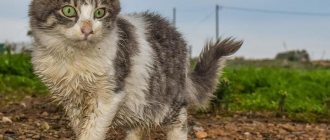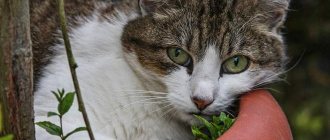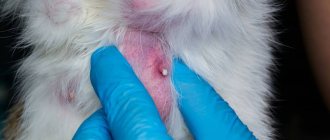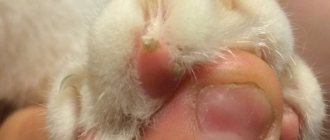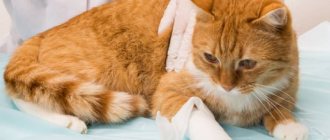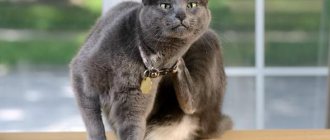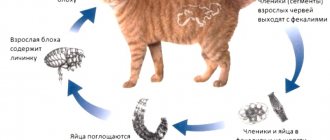One of the reasons why people love pets is their warm, soft fur that is pleasant to stroke. In addition, the coat is a source of pride for many types of cats and dogs, making them beautiful and easily recognizable. However, there are often cases when, due to various ailments, the wool loses its quality, becomes excessively greasy, falls out, or becomes tangled. Veterinarians note that one of the common reasons why feline lovers come to them is a cat’s greasy tail. In this article we will talk about why a cat gets the greasy tail effect and how to deal with it.
Causes of the disease
Cats are graceful and graceful animals, which are very neat and well-groomed. Therefore, it is doubly offensive when a pet has oily hair on its tail. This spoils the impression of your four-legged pet. There are several reasons for the appearance of such a defect - internal and external; let’s look at each of them in more detail.
Domestic
You need to start with the reasons that arise due to malfunctions in the cat’s body. Fortunately there are not so many of them:
- Hyperfunction of the paraanal glands. They are located at the very base of the cat's tail, their function is to lubricate the animal's anus, which makes it easier for him to defecate. When the outlet becomes inflamed or narrowed, there is a delay and accumulation of a foul-smelling substance in the anus. It is important to know that pets that have not been castrated are more likely to develop this disease. Experts say that a possible reason for this is the pet’s elevated hormone levels.
- Dysfunction of the sebaceous glands, which are located directly on the cat’s tail. If their functioning occurs too intensively, then the fat does not have time to spread evenly throughout the pet’s fur, concentrating in one place. In a neglected state, this leads to complete blockage of the glands, which creates a favorable atmosphere for the development of harmful microorganisms. Veterinarians notice that active production of keratin often leads to this. At the site of the lesion, a characteristic black spot may appear - a comedon. Over time, if an infection gets there, it threatens to develop into an abscess on the cat’s skin.
- Hairless and short-haired breeds of cats fall into a special risk group, which is characterized by the effect of a fat tail. It is quite difficult for them to identify it.
External
In addition to internal reasons, there are also external ones that can contribute to the formation of excess fat on a cat’s tail. These include:
- Poor animal hygiene. If a pet is overweight, this makes it difficult for him to attempt self-care. An aggravating factor can be the owner’s inattention to such issues, as well as the cat’s categorical dislike of taking baths.
- Poor nutrition, lack of vitamins. These two factors seriously affect the level of subcutaneous fat production. Therefore, the owner of a “problem” cat needs to carefully monitor his pet’s diet.
In any case, only an appropriate specialist can give a qualified assessment of the reason why a cat’s fur becomes greasy. Do not try to diagnose yourself, this will aggravate the situation, which will make the animal suffer and become even more unsightly.
Tail crease in a cat
The cat's tail is a kind of pendulum, indicating the mood of the animal. It happens that the owner notices an unnatural bend in the tail, which cannot be ignored. In most cases, the cause of a broken tail is injury - fractures, dislocations. If it heals on its own, it often leaves a lifelong injury, characterized by a broken tail.
Causes of pathology
The main reason is a fracture or dislocation of the vertebrae located in the tail. Other causes include a genetic developmental abnormality. It is noteworthy that in kittens of the Burmese cat breed, a crooked tail is a fairly common type of defect that is inherited. Animals with this pathology are culled and not given the opportunity to reproduce.
A dangerous pathology that provokes a twisted tail is neurological disorders. Skull injuries, brain diseases, malignant neoplasms provoke disturbances in the functioning of the nervous system. The tail can break due to various pinching of the spinal roots, injuries to the back and the spine as a whole.
Symptoms and treatment of crease
A fresh wrinkle in the tail indicates a recent injury. Depending on the degree of damage, symptoms may vary.
The main signs of a crease are:
- severe pain in the animal;
- visible tail break;
- tail hot to the touch;
- swelling;
- fecal incontinence;
- thickening on the tail upon palpation.
The location of the damage must be secured with a bandage. This is necessary so that the animal cannot bend it. An X-ray examination will reveal the cause of the fracture. Depending on the severity of the pathology, the animal is prescribed painkillers and sedatives. A tight bandage or plaster is applied. If the cause of the fracture is a neurological problem, then the best solution is surgery.
Symptoms of the disease
Fat tails are much more common in male cats than in male cats. As noted above, animals with short fur are at risk, which complicates the diagnostic process. Let's try to find out what signs clearly demonstrate this disease:
- The epithelium at the base of the fur becomes lumpy, it flakes off and becomes covered with a thin crust of pus.
- The tail, most often at the junction with the body, is thickly covered with fat, which makes the fur begin to shine. The discharge cannot be washed off with shampoo or soap.
- If the disease progresses, the skin at the site of localization will be combed and covered with red pimples. This is how the animal tries to relieve the itching, but only spreads the infection through the skin.
- The area of “greasy” fur becomes exposed over time. This is due to the fact that the hairs gradually break off at their base.
- A symptom that the anus is inflamed may be uncharacteristic behavior when the cat crawls with its butt on the carpet, trying to release excess contents.
- Over time, brown spots may appear on your pet's tail; if left untreated, they will develop into a hard crust, tearing which the cat will injure itself.
Owners who notice that their animal has developed “greasy tail” syndrome should under no circumstances dismiss this problem, attributing it to seasonality or simply the cat’s untidiness. Most often, the true cause lies precisely in a serious illness that has just begun to manifest itself. If you react promptly, it will save a lot of hassle for both the owners and the cat.
Symptoms of hair loss in cats
Photo.
Baldness of a cat Symptoms of baldness will be noticed even by an inexperienced owner. The cat leaves hair everywhere, some parts of the body become bald (the ears, base of the tail, stomach and back are most often affected).
The condition of the skin determines what exactly caused the development of alopecia. In some cases, the cat develops redness in areas of baldness, the skin itches and worries the animal. In case of serious diseases, scabs and ulcers form, the skin peels off, and sometimes small bumps grow.
Areas of baldness can cause discomfort for your cat. If an animal scratches its skin furiously or does not allow itself to be touched, this is a reason to take it to the veterinarian. In the affected areas, the skin may become hot and stiff.
Treatment options
Treating a cat's fatty tail is a long and tedious process. You need to start with a trip to the veterinarian, who will determine exactly what caused the disease and how to eliminate it as quickly as possible. Treatment, as a rule, is based on the fact that the pet begins to take baths more often. To do this, you need to buy special shampoos containing lactic acid. This will perfectly exfoliate harmful keratin accumulations and cleanse the skin, which will create the basis for subsequent therapy.
If the veterinarian determines that the greasy tail is caused by a hormonal disorder, then castration of the pet or medication to stop the production of sex hormones will be required. Excessive production of anal secretions is treated with rinsing. The specialist will clearly explain to the owners how this is done. If the disease recurs regularly, the anal glands can be completely removed surgically.
If the causes are caused by external irritants, then a complex of vitamins and a special diet are prescribed to strengthen the immune system. All this will help the cat become beautiful again, and its owner - calmer. If you ignore the fact that your pet’s tail becomes fat, then in the future this can lead to complete baldness, which will make the animal completely unsightly.
Dangerous skin diseases of cats
Ringworm
Symptoms: hair loss in certain areas of the skin, peeling, the appearance of strange scales, sometimes purulent wounds. Your cat may itch, but ringworm usually does not cause itching.
Demodicosis
A serious disease caused by microscopic mites. It is highly contagious and develops rapidly. The main symptom is severe, constant scabies, the skin becomes covered with red spots. It starts with the head, ears. Without treatment, it quickly spreads to other areas of the body, appearing consistently in the armpits, on the folds, and at the base of the tail.
Factors predisposing to the appearance of demodicosis are improper feeding, maintenance, lack of a number of B vitamins, vitamin A, E, and worms.
Eczema
The main symptom of eczema is a weeping surface of the skin. The cat scratches the affected area, redness and nodules appear on the skin. The general condition changes: a fever develops, the cat loses weight, and kidney problems begin.
Based on skin scraping tests, your veterinarian will rule out other skin diseases and prescribe antihistamines. It is not recommended to treat the cat yourself, as any incorrect treatment can cause additional complications.
Dermatitis
Dermatitis is dangerous due to its unpredictable manifestations. If left untreated in time, they can severely undermine the animal’s immune system.
Bedsores
Necrotic destruction of a cat's skin due to prolonged lying in one place. Manifested by tissue necrosis, death of skin cells. It is observed in sick animals that are forced to remain in one position for a long time. Symptoms: pain when touched, decreased temperature of the dying area, color change, appearance of ulcers. Prevention of the development of bedsores is simple - turn your pet over more often in the postoperative period, do not let him sit on the injured limb for a long time. Treatment comes down to treating wounds, dressings, and removing dead tissue.
Associated with viral infections
Some feline diseases lead to the development of skin problems. For example, with leukemia
the integument is especially severely affected - abscesses, neoplasms, and wounds occur.
Immunodeficiency in cats
causes chronic otitis media with damage to the skin of the ears, and numerous pustules (vesicles with pus) appear on the body. causes damage to the skin of the paw pads and around the nose.
It is important to promptly seek help from a veterinarian to determine the cause of the skin disease. The specialist will determine the main cause of the soreness and prescribe adequate therapy. The cat scratches itself periodically, but looks quite well
However, once again stroking the pet, the owner notices sores appearing in different places on the cat’s body. What are the reasons why, seemingly asymptomatically, a cat develops sores?
The cat scratches itself periodically, but looks quite well. However, once again stroking the pet, the owner notices the cat’s sores
.
What are the reasons why, seemingly asymptomatically, a cat develops sores
?
Among the broad picture of feline skin diseases, a number of particularly common ailments can be identified, as a result of which the cat develops sores.
Seborrhea (dry and oily)
If your pet suddenly starts smelling like a dog, so much so that it becomes difficult to be in the same room with the cat, do not rush to accuse him of being unclean. It is possible that your pet suffers from seborrhea. This is a disease characterized by impaired sebum secretion. If too much of it is secreted, then seborrhea is, accordingly, called “oily.” With insufficient secretion of sebum, a dry type of the disease develops.
Veterinarians are still arguing about the causes of the disease, but to this day many cases must be considered idiopathic, since not a single study has helped to identify a single predisposing factor. In cats, the most common is the “fat” variety.
The clinical picture is quite characteristic. In addition to the unpleasant odor already mentioned above, numerous dandruff appears on the animal’s skin and fur (with the dry variety), or the cat’s tail resembles an unsightly icicle. In the latter case, this happens because the sebum released in incredible volumes simply sticks the hair together.
The intervals between relapses (with proper feeding and good living conditions) can reach several months.
The main predisposing factors are:
- Temperature changes, as well as keeping the cat in rooms with excessively dry air (which is typical for all apartments with central heating).
- It is believed that one of the main reasons for the development of seborrhea in many cases is a variety of allergic reactions.
- The same can be said about diseases of fungal etiology. Pathogenic fungi and yeast have a very bad effect on the condition of the skin.
- “Raw” or “oily” seborrhea is a common consequence of severe hormonal disorders. In particular, it often appears with problems with the thyroid gland.
- Obesity. Firstly, in cats it can also be a consequence of problems with the endocrine glands. Secondly, a “swollen” cat is simply physically unable to take proper care of itself, which makes it much easier for pathogenic fungi to invade its skin. In addition, in such cases, the animal may not have seborrhea, and greasy skin is only a sign of its extreme neglect.
- Diseases of the gastrointestinal tract. If the body does not receive the proper amount of nutrients, micro- and macroelements, the likelihood of developing any diseases becomes many times higher.
- Skin diseases of tick-borne etiology. As a rule, the activity of these parasites leads to the development of a dry type of the disease: mites, gnawing through the outer layers of the skin and actively developing in them, interfere with the normal functioning of the body.
Symptoms and treatment
The symptoms are quite specific, and therefore, as a rule, there are no particular difficulties in identifying the disease. First of all, it is the tail that is affected, which as a result either becomes covered with dandruff, or takes on the appearance of a “greasy icicle.” Abundant dandruff rashes can be found in places where the animal likes to rest; they also become heavily greasy in the case of the oily type of pathology.
Another characteristic sign is very specific, sharp and extremely unpleasant. Experienced owners or veterinarians are able to make a diagnosis as soon as they smell this “aroma.” Note that seborrhea itself does not produce any odor - it is a consequence of the activity of secondary microflora.
As for treatment, it is primarily aimed at eliminating the identified root cause of the disease. Idiopathic seborrhea is treated with special shampoos, which can be purchased at any large pet store. We would recommend consulting with your veterinarian first. It is better when the shampoo is selected by an experienced specialist.
The following products have proven themselves to be effective:
- "Tea tree". It degreases the skin well and has a pronounced anti-inflammatory effect.
- Additionally, any antiparasitic shampoo. It is used in cases where the disease is caused by the activity of fleas, ticks, or other ectoparasites.
- Accordingly, when the disease is fungal in nature, shampoos with an antifungal effect are used.
Recommendations
If an abscess is found in a cat, how to treat it at home? It is recommended to show the animal to a veterinarian to make an accurate diagnosis and prescribe a course of therapy. A disease such as an abscess is common in cats. Since it needs to be opened, it is better to do this at a veterinary clinic.
This procedure can be done in two ways: under local anesthesia or general anesthesia. The veterinarian will determine how this operation will proceed after an examination. And depending on the condition of the animal, he will prescribe which painkiller is best for making the incision.
Although abscess is a common condition in cats, hairless cats are less susceptible to it. The reason for this state of affairs is that cats without fur are kept by their owners in favorable conditions. Therefore, they do not have the opportunity to sort things out with other animals and enter areas other than their own.
As a rule, to eliminate the inflammatory process, cats are prescribed antimicrobial agents. These include sulfonamide drugs. It is necessary to give your pet a course of medications. You should not stop taking medications, even if your cat’s abscess appears to have become smaller. Antibiotics should be taken as a course. It is 5 or 7 days. The bottom line is that when the course of drugs is interrupted, the body can develop immunity to their components. And if you need to take these medications again, they will not have the desired effect on the body.
Why does the hair on my back get oily?
This symptom may be a sign of the development of seborrhea, a skin disease that appears due to a violation of the excretory function of the sebaceous glands. This happens due to improper care.
Frequent bathing, washing with shampoos not intended for animals, liver dysfunction are the main factors that provoke excess sebum secretion.
A lack of vitamins and minerals can affect the condition of a cat's hair. It is worth diversifying your pet's diet, including lean meat and rice, and introducing vitamin supplements to improve the quality of the coat.
Prevention
- Sterilization helps to avoid problems with the greasy tail by ensuring a calm hormonal balance. But it is worth noting that many uncastrated cats never encounter such a dermatological problem.
- A balanced diet and timely consultation with a specialist at the first signs of the disease will help prevent hyperplasia of the sebaceous glands. Preventing obesity throughout a pet’s life and caring for its fur is something any owner can do.
Why is this happening?
Among the causes of baldness are:
- Lichen. Typical signs of lichen: peeling of the tail, parts of the hind legs, back and ears. An accurate diagnosis can only be made in laboratory conditions. The affected areas are illuminated with a Wood's lamp. If the fur takes on a greenish tint, treatment for shingles infection is prescribed.
- Hormonal imbalances. The cat's body secretes a special substance from the upper part of the tail. The pet distributes lubricant throughout the body while washing. Too active secretion leads to the fact that the tail peels off and becomes fat.
- Ticks and fleas. Even a domestic cat can become infected with fleas. Ticks are brought in from the street by other residents of the house. The area of the mane and tail is a favorite place for parasites, after which the cat begins to constantly itch and literally tear out the fur.
- Infection with helminths. These are parasites that form in the body. Helminths are transmitted through raw fish and meat. This leads to the cat having a loose tail, and worms become a related problem.
- Bacteria. Typical for cats that periodically go outside. Untreated wounds on the tail are a target for bacteria, which can lead to critical infection and a threat to life.
- Allergy. If your cat's tail is going bald, it could be a response to an allergy. Among the reasons: poor nutrition, cheap food, intoxication with medications. In addition, some cats react painfully to odors, particularly tobacco smoke.
- Stress. As in the case of the appearance of worms, the tail peels off during strong emotional experiences. In older cats, this is a consequence of the appearance of a new pet - a dog or kitten. In young furry animals, stress manifests itself after major home renovations, childbirth, or moving to a new place.
- Inflammation of the glands of the paraanal type. The animal begins to urinate past the tray, and the fact of irritation is confirmed by a shaking tail, which gradually becomes greasy, peels off and loses its fur.
shutterstock
Endocrine disorders and inflammation of the sebaceous glands
In some cases, a wound on a cat's tail appears due to an imbalance of hormones and endocrine disorders. This is accompanied by systemic disorders - alopecia, obesity, loss of appetite, changes in the behavior of the pet.
Among the dangerous pathologies that provoke the appearance of such a symptom, it is worth highlighting diabetes mellitus. This disease is often diagnosed in obese animals, and develops against the background of impaired carbohydrate metabolism in the pet’s body. One of the specific symptoms of this disease are deep, non-healing wounds and weeping erosions on the animal’s tail. The localization of wounds is associated with the specifics of blood circulation in this area.
Another common cause of erosion is blockage and inflammation of the sebaceous glands. Pathology also refers to endocrine disorders and requires consultation with a specialist. It is not advisable to treat wounds on your own, without specific treatment for the underlying disease, since after a while they will appear again.
As a rule, treatment of endocrine disorders begins with adjusting the animal’s diet. This is followed by drug therapy, including hormonal therapy.
Tail ulcer
Short-haired cats often suffer from ulcers that form on their tails. These ulcers can be located throughout the tail, including at the root of the tail, which can cause necrosis of the vertebrae of the caudal process.
This disease is specific and requires strict pharmacological treatment, as well as special recommendations to the owner for treating the cat at home. The process of treating a tail ulcer also includes cleaning it of dirt and, if formed, a crust. After this procedure, the affected area of the tail should be treated with antiseptic powder and lubricated with a special product prescribed by the veterinarian. Kubatol aerosol is often used for these purposes. After such treatment, the affected area is lubricated with ointment. This can be syntomycin or streptomycin ointment, or liquid Vishnevsky liniment. After treatment, the affected area of the tail should be wrapped with a light bandage for 5 days for protection.
All this time, you need to periodically comb the fur in areas located near the affected area to prevent itching. During the procedures, it is better to protect yourself with the help of a protective circle or a “plant pot” type muzzle.
Any tail disease can only be treated under the supervision of a veterinarian.
If this disease is neglected, your pet may develop gangrene. Therefore, when you first suspect the appearance of an ulcer, you need to take the necessary measures without delay. Otherwise, a situation may arise in which there is no other choice but to amputate the tail.
Main signs of injury
A broken pet's tail is hard to miss. There is no need to have specific knowledge for this. Symptoms of a tail fracture in a cat are particularly pronounced, manifesting themselves in the form of a break and deformation.
A closed-type fracture is defined as a displacement of the vertebrae, and from the outside it looks like a slight swelling. The open type of fracture is characterized by protrusion of the vertebrae outward through the wound surface, accompanied by rupture of muscle fibers, as well as small and large vessels.
When tail fracture occurs, the animal experiences severe pain, falls into an aggressive state, and reacts sharply negatively to even the slightest touch to the affected area. Damaged large nerve fibers cause tail paralysis. The animal cannot control the tail process, dragging it along the ground.
In veterinary medicine, loss of sensitivity in the hind legs due to tail fracture is often diagnosed, negatively affecting the pet’s further movement. The cat walks unsteadily and has a shaky gait.
Dislocation of the vertebrae in the tail is characterized by other changes, unlike a fracture. The owner may notice changes in the shape of the organ; it looks severely deformed, in some cases it is folded at an angle.
When the tail is dislocated, sensitivity decreases, and the tissue structures surrounding the damaged part are hyperemic and swollen, and pain is noted.
The corresponding classification, dividing fractures into several types, helps to assess the degree of damage. There are:
- Open fracture
- characterized by damage to the vertebrae with a violation of the integrity of the skin structures. With an open fracture of the tail, vertebrae, muscles, ligaments and blood vessels are visible. - A closed fracture
is more often diagnosed in cats and is characterized by the absence of a violation of the integrity of the skin at the site of injury. At the site of injury, pronounced swelling and changes in the angle of the caudal process from the physiological norm are noticeable.
There is also incomplete fracture, which is observed in young animals. The bone structures of kittens are not as strong as those of adults, but are more flexible. When hit by a vehicle or pinched by a door, the vertebrae in the tail of young cats break and cracks form, which heal on their own over time.
